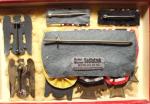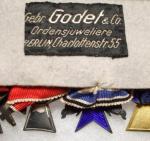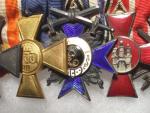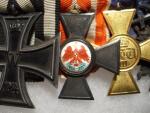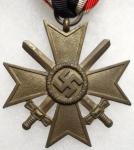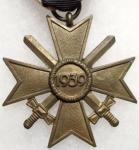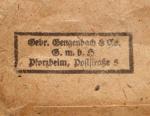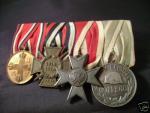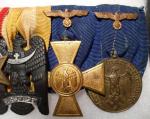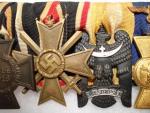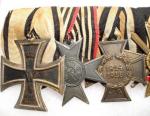-
Posts
718 -
Joined
-
Last visited
-
Days Won
7
Content Type
Profiles
Forums
Blogs
Gallery
Events
Store
Everything posted by tyanacek
-
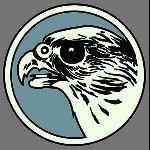
Schlesischer Adler / Silesian Eagles
tyanacek replied to dond's topic in Germany: Weimar Republic & Deutsche Freikorps
Hello to all, This nice little grouping belongs to a collector friend of mine. The recipient was awarded both the First and Second Class Silesian Eagles in December of 1919, while serving as a Kanonier with Reichswehr-J?ger-Bataillon Nr. 8. In WWII, he attained the rank of Flieger-Stabsingenieur. Best regards, Tom -
OMG! How cool is that? Thanks to everyone who responded to this thread and a very special THANK YOU to both Rick and Daniel. You guys are absolutely amazing. I think I'm almost as excited about the how/why of the Hindenburg Cross placement as I am about the identification of the medal bar. With sincere gratitude, Tom
-
Hello Rick, Thank you once again for sharing your expertise. Just a bit of confusion, though, on my part. Are you saying then, that my Leser MVO4X has a silver gilt center? I know it doesn't look like it in the picture, but in-hand and in good light, I would swear that mine has a real gold center. The reverse lower cross arm does not have a wider edge on mine. Does the wider-edged, lower reverse cross arm imply silver gilt center or real gold center? The backing material on my bar is light gray. I have attached a picture of the medal bar reverse, plus a closeup picture showing the normal width lower reverse cross arm of the MVO4X. Best regards, Tom
-
Hello Sascha, Thank you for the assistance. I knew the MVO4X was not a Weiss or Hemmerle, so I think it is probably a Leser as you say. Did Deschler also produce the MVO4X? I have posted a larger picture of the MVO4X, which I hope will help in making a positive identification of the manufacturer. The Red Eagle Order is clearly a Wagner by virtue of the center medallion artwork. Thanks again for your assistance. Best regards, Tom
-
Hello to all, I didn't see too many nice bars at this year's SOS. However, I did find a nice Baden Officer's bar as well as an eight-place bar to an old Prussian Officer. The Prussian Officer's bar is a Godet assembly. The Red Eagle Order is by Wagner. The MVO4X has a real gold central medallion, but I am uncertain of the maker. (A bit of enamel damage to the lower cross arm, ouch!) The 1914-1918 Cross of Honor is by Paul Meybauer of Berlin. Best regards, Tom
-
Hi again Walle, Here is the Hindenburg Cross I was referring to with big G little G marking. This marking is impressed into the surface. It could very well be a logo that was used by Gebr?der Gengenbach. I suppose it could also be a logo used by Gebr?der Godet, but Godet usually had their name spelled out in relief on their Hindenburg Crosses. Best regards, Tom
-
Hi Walle, I have attached images of the exact KVK2X that came in the Gengenbach packet, when purchased from a dealer many years ago. The cross is a die-forged zinc example, with a pretty decent bronze color wash remaining. There is no maker marking on the suspension ring and it came with a full-length ribbon. The cross looks to be in unissued condition so it might be original to the packet, but who can really say for sure. Maybe you can compare the details of this one to your cross and look for similar die-strike characteristics? Best regards, Tom
-
Hello Walle, In my opinion, your KVK2X packet is completely original. I have heard of this company name before, but like you, I have never been able to locate a Lieferant, LDO, or RZM Number for them. The reason I have heard of this company name before, is because I also have a KVK2X packet by this manufacturer. I will try to post a few pictures, but it might take me awhile to locate the packet. If I do not post it by tomorrow, it will have to wait until early next week as I will be out of town for a few days. I think this company also manufactured the 1914-1918 Cross of Honor and used the logo of a large letter G with a smaller letter G inside. Best regards, Tom
-
Better pictures make such a difference. This badge was definitely cast using an original Schwerin badge as the model. Casting flaws are everywhere on both the front and back. These flaws were not apparent in the angled shot of the front that started this thread. As Martin mentions, the attachment hardware on this badge is nothing like that found on originals. This casting also captured the soldering seepage that was present on the original badge, obscuring part of the maker markings. Best regards, Tom
-
Hello to all, This is my first, but hopefully not last, medal bar for the New Year. I am very fortunate to be the new custodian of this medal bar, which belonged to Ministerialdirigent Heinrich Barelmann. He was LD7 Department Chief in the RLM. His administrative rank was equivalent to that of Luftwaffe Generalmajor. In World War One, he was in the Navy and involved in naval construction. His only decorations in World War One were the 1914 Iron Cross Second Class and the Oldenburg Friedrich August Cross Second Class, both decorations with combatant ribbons. (Thanks for confirming that for me, Rick!) He received his 4 and 12-Year Long Service Medals in 1936 and his 18-Year Long Service Cross in 1938. His only decorations in World War Two were the 1939 KVK2X (awarded in 1941) and the 1939 KVK1X (awarded in 1942). He retired in May of 1944, before things reallly turned to crap. Although it has no enameled Imperial Orders, I like it all the same. Hope you like it too. Here is a link to a photo and some career information: http://www.geocities.com/~orion47/WEHRMACH...N_HEINRICH.html Best regards, Tom
-
Hello KDVR, Just based on the front picture alone, I see no immediate indications that this badge is fake. The detail looks acceptable and the porthole count on the ship is correct. However, without seeing a picture of the reverse, I doubt that anyone will be able to tell you whether or not the badge is original. I would never buy it based on just this one picture. Best regards, Tom
-
Hi Fariz, If the badge is Buntmetall/tombak, the catch will be attached directly to the badge (just like in the example pictured above). If the badge is zinc, the catch will be attached to a round catchplate which is then soldered to the badge. The zinc badges also have raised guide lines on the reverse for proper location of the hinge and catchplate. Tombak-based badges will shown evidence of yellow-colored metal at areas where the finish is worn away. Zinc-based badges will appear dull and gray in color. Best regards, Tom
-
Hello Fariz, Not exactly sure what you mean by "splattering." The detail to the sword hilts on L/53 Wound Badges is usually well-defined. But zinc badges with plated finishes can oftentimes display bubbling to the finish, which can obscure the detail of the badge. Also, if the badge is heavily worn, that might explain the lack of some detail. If you can show a few pictures of the badge, that would be a big help. Best regards, Tom
-
Hello Fariz, I believe Hymmen & Company had at least two different dies for Silver & Gold Wound Badge production. Most of the examples encountered will display the L/53 marking (in relief) on the center reverse. There are originals, though, that have the L/53 marking (also in relief) directly below the catch. Relief type markings were cut into the actual die that produced the badges, so you will not see relief markings in different locations unless there was more than one set of tooling. Stamped markings that were punched in after badge production can vary considerably in location. Here is an L/53 relief marking directly below the catch: Best regards, Tom
-
Hi Paul, Here are some closeup shots of the medal bar. I hope these pictures are better. Unfortunately, it seems that I always have to compress down the images so as to be within the allowable posting size. This is one of the reasons I never liked posting things on this otherwise great forum. Best regards, Tom
-
Hi Paul, Yes indeed! The order of precedence is correct on this bar except for the placement of the 1939 KVK2X, which should actually be in the #2 spot. In a perfect world where everyone understood all of the regulations (and willingly obeyed them) you would never see a mistake such as this. But the fact of the matter is that these bars were hand-assembled by human beings (and civilians to boot) so mistakes in order placement were frequently made. In my opinion, the incorrect placement of a 1939 KVK is a fairly common mistake, especially prior to the 1942 regulations. Prior to 1942, there was confusion because the War Merit Cross was ranked after the Iron Cross and before the 1914-1918 Cross of Honor. The War Merit Medal was ranked after the 1914-1918 Cross until 1942, when it was elevated to the status of the War Merit Cross. I wonder: How many civilian assemblers realized the difference between a 1939 War Merit Cross and a 1939 War Merit Medal? We can't forget either, that some of these WWI veterans didn't give a damn about the regulations. Many valued their WWI decorations more highly than a 1939 KVK. So whether this was a simple mistake or intentionally done, it is by no means an uncommon thing. Best regards, Tom




